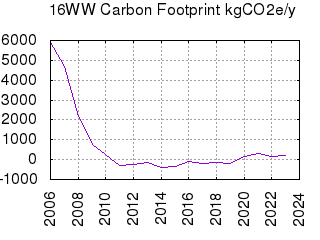Earth Notes: Saving The Planet @Home
Site updated 2025-07-05 08:25 GMT.Want to do your bit at home to improve your quality of life, save money, cut down on waste and carbon pollution, and get the planet back how it used to be?
Did you know that the majority of your neighbours are undertaking energy saving actions every day
? That is also one of the most powerful messages to encourage people to save.
On Earth Notes
Featured: 11 Years of Home ASHP, Kingston-upon-Thames London: Case Study (microgen research review)
Learn from a home air-source heat-pump experience in greater London, UK, a decade in. #ASHP #heatpump
On Setting Up a Raspberry Pi Off-grid PV-Powered Server (2014) (frugal tech)
Saving Electricity and Gas (easyread frugal microgen)
16WW Heat-pump Control (frugal microgen research tech)
General Bibliography (dataset short tech)
Net utility (electricity) CO2 emitted this year over first 6 months: 29kg
LIVE GB Grid Carbon Intensity (mobile), live grid-tie PV generation and off-grid PV electrical system stats, heat battery top-up control.
Main FEEDS site, podcast, data.
SECTIONS dataset, frugal, microgeneration, podcast, research, review.
OFFLINE Download to your computer before a long journey with poor connectivity. Unpack and read offline. (Also see Zenodo.)

Things That We've Done
We've crunched our carbon footprint. We've become a SuperHome. We've pondered other changes that we might make. But most of all there's been quite a lot of fun learning. Maybe it is my engineering mindset, but I have made a hobby out of conservation and meter watching. I have had fun out of 'tuning' life a little. The rest of my family humours me! See a full list of articles under search at the top of the page, and here's some actions to start with that we took...
Things That You Can Do
Effective changes that can be made at home are based on lowering energy/resource demand...
- Saving electricity (and gas) in all sorts of ways, including,
- Lighting: low-energy light bulbs (eg CFL / compact fluorescent and LED preferably at 60 lumens per Watt (60lm/W) efficiency or better). If rewiring, then look at 12V light circuits connecting to PV/battery systems.
- High-efficiency white goods (eg fridges) and other electrical goods at home and at work. Look at energy consumption in use, eg per wash or while on, and in 'standby' mode if you won't be turning them off at the wall. Choose an energy supplier that provides 'green' energy and supports renewables.
- For cooking: investigate CO2 savings with induction cookers and microwave ovens.
- Clothes washing: alternate ideas with drying (eg on a line), and low-temperature (cold/30°C/40°C) washing and do full loads. Also, simple changes in habits and textiles (wool is brilliant compared to cotton for whole-life costing as well as washing/drying/ironing). Re-use fashions!
- Low water-use toilets, showers.
- Insulation and thermal capacity (over-cladding buildings).
- Close curtains at dusk to retain heat (and on hot sunny days to keep the sun/heat out).
- Turn down your heating thermostat 1°C for up to 10% saving. 18°C to 21°C is about right during the day (and hypothermia is only really a risk when temperatures at home are as low as 5°C, but spending more than two hours at 12°C raises blood pressure), and nearer 14°C at night when sleeping. Only heat rooms that you are using. Use a timer (or something smarter) to avoid heating when no one is home! Wearing the right clothing helps keep you comfortable at lower temperatures.
- Don't have your hot water thermostat set higher than 60°C/140°F, and 'instant' water heaters avoid losses from a tank for new systems.
- Don't leave gadgets and appliances on standby/charging, turn them off (maybe with a smart power-strip or trailing adapter) or unplug them. You might trim as much as 30% off your electricity bill.
- Check your mains electricity use at home with tools such as the Kill-a-Watt meter, or just read your supply meter daily or weekly. Gas too.
- Minimise the electricity you use at times of peak grid load (eg 4pm to 9pm in the autumn/winter in the UK) since more carbon-intensive and expensive fuels may be burnt in 'peaking' plants, and the grid is under most strain too. Intensity at peak time circa 2009 was ~0.6kgCO2/kWh, as much as 50% over typical levels.
- On the flip-side, make good use of energy when it's abundant such as saving up computing work until the sun is shining for low-carbon results.
- Reduce, re-use, recycle (including electricals).
- See some thoughtful tips at MoneySavingExpert.com.
News
- : UK solar roadmap [govUK2025solar] published.
- : China hits 1 TW solar milestone:
China reached its first 1 GW of installed solar in 2010...
- : Ireland shuts last coal plant, becomes 15th coal-free country in Europe.
- : Sizewell C power station to be built as part of UK's £14bn nuclear investment.
- : DESNZ: Over 22,000 domestic batteries installed in past year totalling 193MWh, with a median cost of ~£1/Wh for smaller systems, falling to ~60p/Wh for systems between 11 and 29.99kWh.
- Archived news...
References
- [baldwin2016past] Past-focused environmental comparisons promote proenvironmental outcomes for conservatives
- [govUK2025solar] Policy paper: Solar roadmap
(Count: 2)